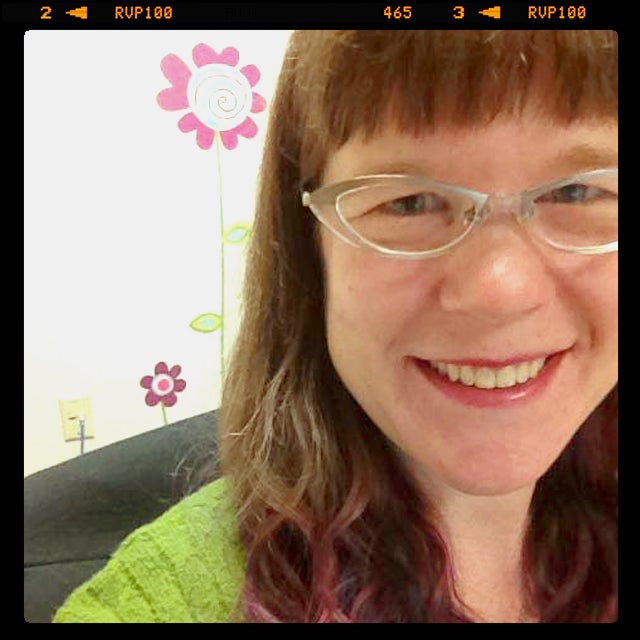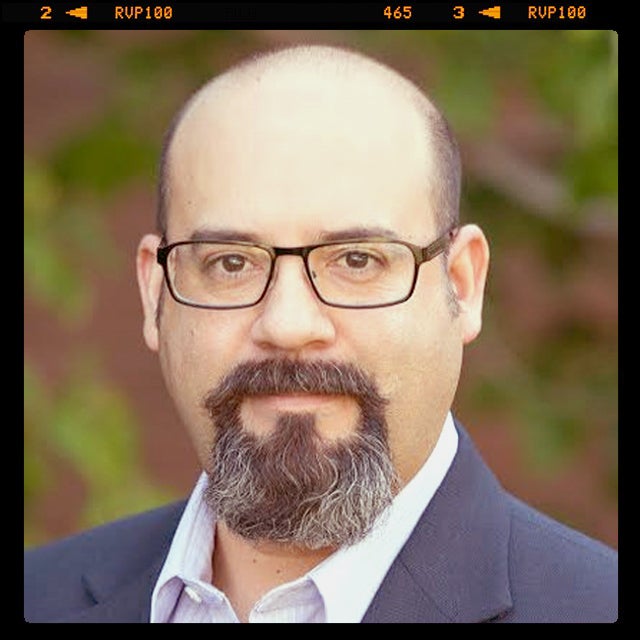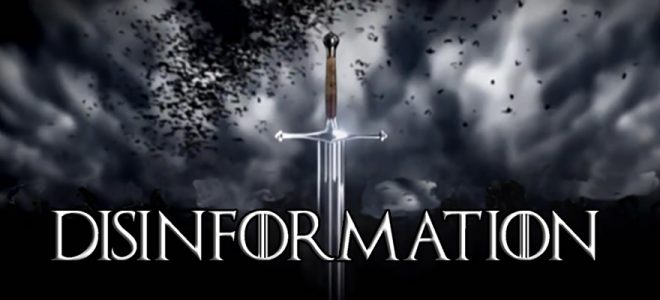
Deana Brown is an Assistant Professor and Librarian at Boise State University’s Albertsons Library. She liaises with the Gender Studies Program, and departments of Philosophy, Psychology, and Sociology. Her research areas include applying user experience principles to library services, investigating the impact of impostor syndrome and library anxiety on users, and developing active learning opportunities. She has taught courses on learning and library research skills, and hosts a Knitting for Stress Relief event in the library during each finals week.

Memo Cordova is an associate professor/librarian at Boise State University’s Albertsons Library. His research interests center around disruptive technology systems and their impact in libraries, education, and the humanities.
GAME OF THRONES CALLING OUT POLITICAL CLIMATE?
Imagine you are sitting at home having just finished Sunday dinner when there is a knock at the door. Your friends have arrived to watch the Season Finale of your favorite show, Game of Thrones. The finale revolves around a number of warring houses whose past betrayals and chicaneries have made it difficult to join together and unite against an unimaginable threat.
The room falls silent with anticipation as the theme music starts playing, transporting everyone to George R.R. Martin’s medieval fantasy world of Westeros. Popular shows like Game of Thrones help viewers escape the realities of life. However, this imagined world can sometimes come crashing down with the sudden intrusion of reality. As it happened with this Season Finale – one of the leading characters, Jon Snow, fails to rally the houses. Past deceits have made it impossible for the houses to join together and defend their kingdoms. After the failed negotiations he cryptically states, “When enough people make false promises, words stop meaning anything. And there are no more answers, only better and better lies, and lies won’t help us in this fight.”
That simple but powerful statement disrupts your flight of fancy. We can assume Game of Thrones scripts are written far in advance of filming, but one cannot help but wonder if Jon Snow’s character was referencing our current political climate. A Variety interview with Liam Cunningham, who plays Davos Seaworth, says as much: “That speech that Jon Snow gave about the nature of lies and what’s been said, and what happens if we don’t stick to our word — we filmed that on exactly the day that a certain POTUS was elected and it had incredible resonance while we were filming it.” This stirring speech, born out of frustration, was surely not lost on many of the 16.5 million viewers who saw the Season 7 Finale.

MISINFORMATION BLOSSOMS…AGAIN
As librarians, we are also frustrated. We take issue with disinformation and the term “fake news” creeping into our realm. The term “fake news” in particular is sophomoric and offers nothing of value as a way to convey how distorted and diluted information can be injurious to an informed society. A better term may in fact be ‘misinformation’. The first recorded instance of the term “misinformation,” according to the Oxford English Dictionary, comes by one Abraham Fleming from his 1587 book, Holinshed’s Chronicles. Described as, “The action of misinforming someone; the condition of being misinformed” and as having “Wrong or misleading information.”
Although the use of misinformation has been around for at least 500 years, the Internet has greatly facilitated its propagation and dissemination. Social media has helped spread it. The current White House administration regularly amplifies it. Fake news has become the monster stepchild of conspiracy theorists and satirical news sources. Its reach colors and pervades our socio-political environment and affects our cultural worldview. It is insidious in its perfidy.
Americans consume news and information from a variety of sources. An August 2017 Pew report found that two-thirds (67%) of Americans report they get at least some of their news via social media. Up-to-the-minute news access can exacerbate our ability to adequately consume information. Not to mention thinking critically about it before sharing it with others. Embedded in this stream and constant flow of information can be half-truths, deceitful rhetoric, misinformation, and downright lies. The hazard being that this river of information can shift before we have time to process it properly; that is, before news events can be filtered, checked, sanitized, and converted into chewable bits our minds can digest.
 “Falsehood flies, and the Truth comes limping after it.” – Jonathan Swift, 1710.
“Falsehood flies, and the Truth comes limping after it.” – Jonathan Swift, 1710.A key component of misinformation is to sow doubt. Another Pew survey in December 2016 on the influence of fake news found that “About two-in-three U.S. adults (64%) say fabricated news stories cause a great deal of confusion about the basic facts of current issues and events. This sense is shared widely across incomes, education levels, partisan affiliations and most other demographic characteristics.” Blatant lies can be readily dismissed, but news that skirts the truth or obfuscates can make it onerous to parse out the truth. And therein lies its dastardly aim: to combat it, or counter it, or meet its claim we must prove it wrong; and as such it becomes an exhausting and time-consuming task to disprove it. Combating a lie requires more energy and time than it warrants. As Jonathan Swift so aptly put it,
Besides, as the vilest Writer has his Readers, so the greatest Liar has his Believers; and it often happens, that if a Lie be believ’d only for an Hour, it has done its Work, and there is no farther occasion for it. Falsehood flies, and the Truth comes limping after it; so that when Men come to be undeceiv’d, it is too late; the Jest is over, and the Tale has had its Effect…
Neutralizing fake news is not easy; it does not have a centralized outlet or nucleus that can be targeted. Its effects during the 2016 elections have been brought to light in part thanks to the endless reporting of traditional media outlets. Each political party spent millions of dollars on commercials, radio and newspaper advertisements, posters, and social media outlets. Moreover, foreign meddling the United States was subjected to leading up to the 2016 presidential election continues to undermine and influence the American political landscape. A January 2017 assessment by the U.S. Senate Select Committee on Intelligence states that “Moscow’s influence campaign followed a Russian messaging strategy that blends covert intelligence operations—such as cyber activity—with overt efforts by Russian Government agencies, state-funded media, third-party intermediaries, and paid social media users or “trolls.” And that “Russia’s intelligence services conducted cyber operations against targets associated with the 2016 US presidential election, including targets associated with both major US political parties.”
Through it all, the “truth” inherent in the message began to slowly mutate into something different. The political climate around the 2016 election began to exude a toxic mix of exaggerated claims and half-truths. Fact checker websites like FactCheck.org and Snopes.com had no shortage of content to separate fact from fiction, and saw a surge of media propagating misleading or factually wrong data. For example, Snopes archives its most popular tags from questionable sources fact-checked by its editors. These include “Election 2016” and “Fake News”, each with over 230 sources.
The prevalence of “fake news” and misinformation is such a contentious and far reaching issue that it has prompted the development of curricula to address it. Examples include professors from the Information School and Biology Department at the University of Washington creating a new course to address fake news, titled “Calling Bullshit.” Similarly, Stanford’s Law School developed “Policy Practicum: Fake News and Misinformation”, designed to support the creation of “interventions in the spread of fake news and misinformation which also promote accurate information for a healthy, deliberative democracy.” Virginia Commonwealth University launched a “Vet Your Sources” (#vetyoursources) campaign to, “encourage all in the VCU community to carefully evaluate their sources of information.” Its success prompted them to invite other universities to join, which Boise State University and Albertsons Library did in 2017. Misinformation is not a localized event, it has pervaded the fabric of our democracy at an alarming rate.

THINGS YOU CAN DO
Above all, take solace that fake news and misinformation are not new, and people have overcome it in the past and certainly will do so in the future.This can all seem overwhelming at best, and disheartening at worst. However, librarians, information professionals, and other educators meet this threat regularly. Librarians are no strangers to conspiracy theories, alarmist news sources, satirical sites, or the “yellow journalism” that has been around since the beginning of the 20th Century. This is not a new threat. To better arm yourself to neutralize this recurring phenomenon we present you with the following tips:
1. Know your “fake news”
How can you think critically about something you are unaware of? Bill Adair, creator of PolitiFact, defined 3 basic categories of fake news, as shown in Library Journal’s online course, “Fighting Fake News”:
- False stories written with “click-baiting” headlines to get clicks and make money from advertising revenue.
- False or misleading stories written as propaganda for a particular viewpoint or to cause a disruption.
- Satirical or comedic news stories that might be mistaken and shared as real news.
2. Be aware of the backfire effect
Shankar Vedantam addresses the backfire effect on his show, Hidden Brain, where he points to the research of Tali Sharot, a cognitive neuroscientist at University College London, and her colleagues Cass Sunstein, Sebastian Bobadilla-Suarez and Stephanie Lazzaro. “When people heard information that confirmed their pre-existing views, those opinions were strengthened. But when people received information that contradicted what they believed, they simply dismissed the information. Sharot says this explains why more information often doesn’t produce the effects we expect.”
3. Just stick to the facts
Librarians are uniquely poised to provide guidance on having conversations about polarizing topics. We experience them everyday during reference desk transactions and work through them with something called the reference interview. Librarians avoid language that can trigger emotions and defensiveness. Instead, we empathize with our users, validate their research interest, and establish a common goal of meeting their information need. Then we work together as allies in searching for credible sources.
4. Have empathy for people
You can still have empathy for a person, but not agree with their beliefs–it might be the idea you’re opposed to, not the person. Brene Brown breaks down empathy into its four qualities of “perspective taking, staying out of judgement, recognizing emotion in other people, and communicating that.” The next time someone shares something you disagree with, ask yourself if you are jumping to a place of judgement. Be aware of the emotions you are having in response to their statement, and realize they might be having similar emotions if you shared your views.
5. Find unbiased information at your library
Librarians are stewards of information and follow the American Library Association’s Code of Ethics, which states, “We distinguish between our personal convictions and professional duties and do not allow our personal beliefs to interfere with fair representation of the aims of our institutions or the provision of access to their information resources.” Your local librarian is there to help you wade through information and guide you to resources that fit your information need. We do this for everyone, regardless of socio-economic standing. By democratizing access for all, librarians have become the most trusted profession after nurses, based on a study by the Maine State Library.
6. Web tools to consider
Stay grounded in neutral evaluation criteria using Albertsons Library’s News Literacy guide. There you will find a set of tools and exercises curated by library faculty to combat misinformation. For example, the CRAAP test News Edition, is a set of criteria that encourages non-emotional questioning and applies to all news sources without favoring any specific set of beliefs. Another tool is a list of news sources categorized by news source type. This resource was compiled by Melissa Zimdars, a mass communications instructor at Merrimack College, and has been developed into an open-source browser plug-in called the B.S. Detector. This multi-browser plug-in will notify you if you are on one of the sites on the list.

Let us go back to the fanciful world of Westeros, and the Season Finale where another character, Sansa Stark, a once naive but powerful daughter of a respected house, suffers from the evil machinations of another. Over time, she sheds her naiveté, learns from her past mistakes and becomes aware of the evil underpinnings trying to subvert her kingdom. From a librarian’s perspective, Sansa Stark critically reflected on her past experiences. She became aware of disconnects between what she had been told by those wanting to subvert her, and what she was experiencing. Sansa, once noticing the power dynamics starting to play out, decided to take swift and decisive action. Be more like Sansa.
Above all, take solace that fake news and misinformation are not new, and people have overcome it in the past and certainly will do so in the future. You are not alone in your fight to combat misinformation. Librarianship is a profession full of entrusted and experienced individuals who model critical thinking behaviors while meeting your information needs.
